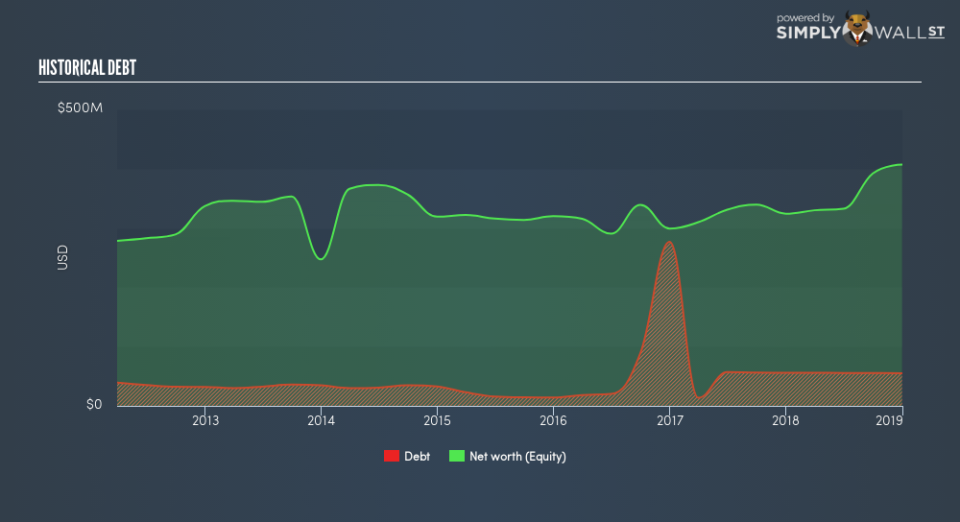Can The Bancorp, Inc. (NASDAQ:TBBK) Survive The Next Financial Crisis?

Want to participate in a short research study? Help shape the future of investing tools and you could win a $250 gift card!
The Bancorp, Inc.’s (NASDAQ:TBBK) profitability and risk are largely affected by the underlying economic growth for the region it operates in US given it is a small-cap stock with a market capitalisation of US$494m. Since banks make money by reinvesting its customers’ deposits in the form of loans, strong economic growth will drive the level of savings deposits and demand for loans, directly impacting the cash flows of those banks. After the Financial Crisis in 2008, a set of reforms called Basel III was created with the purpose of strengthening regulation, risk management and supervision in the banking sector. These reforms target banking regulations and intends to enhance financial institutions’ ability to absorb shocks resulting from economic stress which could expose banks like Bancorp to vulnerabilities. Since its financial standing can unexpectedly decline in the case of an adverse macro event such as political instability, it is important to understand how prudent the bank is at managing its risk levels. High liquidity and low leverage could position Bancorp favourably at the face of macro headwinds. A way to measure this risk is to look at three leverage and liquidity metrics which I will take you through today.
See our latest analysis for Bancorp
Is TBBK’s Leverage Level Appropriate?
A low level of leverage subjects a bank to less risk and enhances its ability to pay back its debtors. Leverage can be thought of as the amount of assets a bank owns relative to its shareholders’ funds. Though banks are required to have a certain level of buffer to meet its capital requirements, Bancorp’s leverage level of 10.95x is significantly below the appropriate ceiling of 20x. This means the bank has a sensibly high level of equity compared to the level of debt it has taken on to maintain operations which places it in a strong position to pay back its debt in unforeseen circumstances. Should the bank need to increase its debt levels to meet capital requirements, it will have abundant headroom to do so.
What Is TBBK’s Level of Liquidity?


As I eluded to above, loans are relatively illiquid. It’s helpful to understand how much of this illiquid asset makes up the bank’s total asset. Usually, they should not be higher than 70% of total assets, which is the case for Bancorp, with a ratio well-below the maximum level at 34%. At this level of loan, the bank has preserved a high level of liquidity but perhaps at the cost of producing interest income from illiquid loan.
Does TBBK Have Liquidity Mismatch?
Banks operate by lending out its customers’ deposits as loans and charge a higher interest rate. These loans tend to be fixed term which means they cannot be readily realized, yet customer deposits on the liability side must be paid on-demand and in short notice. The disparity between the immediacy of deposits compared to the illiquid nature of loans puts pressure on the bank’s financial position if an adverse event requires the bank to repay its depositors. Since Bancorp’s loan to deposit ratio of 38% is extremely below than the appropriate maximum of 90%, this means the bank is lending out less than half its total deposits and placed the bank in very cautious liquidity position as it has not lent out the majority of its deposits and has retained an extremely high level of deposits. Given the substantial headroom for growth in loans, the bank has opportunity to grow its interest income.
Next Steps:
Bancorp passes all of our liquidity and leverage checks which shows it is prudent in managing those factors. This gives us confidence in the operational side of the business, an important aspect to consider before investing in the stock. The bank’s favourable liquidity and leverage position exposes it to less risk when it comes to repaying financial obligations, in particular, in the case of an adverse macro event. Keep in mind that a stock investment requires research on more than just its operational side. There are three key aspects you should look at:
Future Outlook: What are well-informed industry analysts predicting for TBBK’s future growth? Take a look at our free research report of analyst consensus for TBBK’s outlook.
Historical Performance: What has TBBK’s returns been like over the past? Go into more detail in the past track record analysis and take a look at the free visual representations of our analysis for more clarity.
Other High-Performing Stocks: Are there other stocks that provide better prospects with proven track records? Explore our free list of these great stocks here.
To help readers see past the short term volatility of the financial market, we aim to bring you a long-term focused research analysis purely driven by fundamental data. Note that our analysis does not factor in the latest price-sensitive company announcements.
The author is an independent contributor and at the time of publication had no position in the stocks mentioned. For errors that warrant correction please contact the editor at editorial-team@simplywallst.com.

